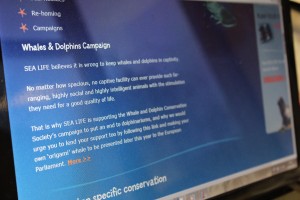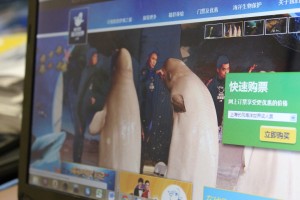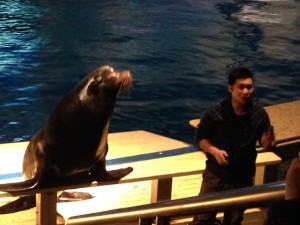
Sea Life states on its website: “Sea Life believes it is wrong to keep whales and dolphins in captivity. No matter how spacious, no captive facility can ever provide such far-ranging, highly social and highly intelligent animals with the stimulation they need for a good quality of life.” Indeed, the company claims to be supporting the efforts of conservation charity Whale and Dolphin Conservation (WDC) in bringing an end to dolphinaria in Europe[i].
Sea Life’s apparent concern over cetacean captivity led to its public opposition to a permit application made by a consortium of US-based aquariums to import beluga whales from the wild in order to populate their attractions. Sea Life joined whale and dolphin conservation groups in a call to the US Federal Government to refuse the application[ii]. On 6th August 2013, the application was denied and the move was celebrated as a victory amongst animal protection advocates.
At the same time that the application was being considered by the US government, three  beluga whales were performing tricks for audiences alongside sea lions in the Chang Feng Ocean World aquarium in Shanghai. The beluga whale show was reportedly part of a new programme developed for 2013 and an investigator confirmed that the whale show was ongoing in early 2014. The Chang Feng aquarium is owned by Merlin Entertainments and operates under the Sea Life brand.
beluga whales were performing tricks for audiences alongside sea lions in the Chang Feng Ocean World aquarium in Shanghai. The beluga whale show was reportedly part of a new programme developed for 2013 and an investigator confirmed that the whale show was ongoing in early 2014. The Chang Feng aquarium is owned by Merlin Entertainments and operates under the Sea Life brand.
The site was bought in 2012 by Merlin and an interview with a senior manager in press in October 2012 queried the company’s stance on captive cetaceans; specifically drawing attention to the stated policy against keeping whales and dolphins which appeared to conflict with the keeping of beluga whales in Shanghai.
 The spokesperson suggested that the policy in practice was more flexible than the firm statements on the company’s website might suggest, saying: “we understand that [opposition to keeping cetaceans in captivity] is not the view in all cultures, and given Merlin’s fast growth, we have at times acquired businesses which historically have included shows or displays which involve these creatures. This has never been a reason not to take on a good business”[iii].
The spokesperson suggested that the policy in practice was more flexible than the firm statements on the company’s website might suggest, saying: “we understand that [opposition to keeping cetaceans in captivity] is not the view in all cultures, and given Merlin’s fast growth, we have at times acquired businesses which historically have included shows or displays which involve these creatures. This has never been a reason not to take on a good business”[iii].
He went on to say that: “In the short term, we will for example completely cease or review ‘shows’ involving such creatures”. However, almost two years after Merlin purchased the Shanghai aquarium, the whales continue to perform daily, with no sign that the company has attempted to bring the spectacle to an end. Indeed, the Beluga whales appear to be the major selling-point of the aquarium with Beluga whale toys filling the gift shop and even the Shanghai Sea Life centre’s logo depicting a Beluga whale. In addition, sea lions perform at the aquarium in the type of circus-style show that will be banned in travelling circuses in England in the coming years. There is no mention whatsoever of the Beluga whales on any Merlin or Sea Life websites and a weblink included on the Merlin website under the Chang Feng Ocean World name links to another aquarium’s website; one which is not owned by Merlin[iv]. The Chang Feng Ocean World website does, in fact, showcase the Beluga shows[v], but no link to this site can be found from any online resource published by Merlin.
The Shanghai aquarium is not the first Merlin business to house captive cetaceans as, in November 2006, Merlin announced its acquisition of the Italian theme park ‘Gardaland’ which operated one of Europe’s largest captive dolphin shows and housed six dolphins at the time: Nau, Ted, Betty, Robin, Tango and Mia. Betty and Robin had been captured from the wild in the 1980s. Tango died in 2008, whilst under Merlin’s care.
Upon discovery of the acquisition of this first park, UK based charity, Marine Connection, working for the protection and welfare of dolphins and whales worldwide, immediately raised concerns. Merlin responded stating that the welfare of dolphins at Gardaland would be the “overriding consideration governing all decisions on their behalf”[vi].
 Following the acquisition of Gardaland, in 2007 Merlin Entertainments went on to acquire the Tussauds Group whose facilities include Heide Park in Germany; another park which featured a dolphin pool with at least one dolphin housed there at the time of acquisition.
Following the acquisition of Gardaland, in 2007 Merlin Entertainments went on to acquire the Tussauds Group whose facilities include Heide Park in Germany; another park which featured a dolphin pool with at least one dolphin housed there at the time of acquisition.
In response to criticism over its apparently contradictory stance on cetacean captivity, Merlin released a statement in 2012 claiming that the company was planning to create a sanctuary for the Gardaland and Heide Park dolphins[vii]. However the Heide Park dolphins had already been transferred to Nuremberg Zoo by Merlin in 2008 and the Gardaland dolphins were sent to Genoa Aquarium in 2013. It is unclear whether or not Merlin retains ownership of the animals. At present, all continue to be on public display (including ongoing dolphin shows at Nuremberg) and no evidence of a sanctuary being developed was available in the public domain in March 2014. This is in spite of repeated references to the sanctuary plans made in press statements by Merlin.
Freedom for Animals contacted Merlin in March 2014 to request information on the progress of the proposed sanctuary received a response just days before the launch of the new campaign. Merlin told Freedom for Animals that feasibility studies have been carried out and a site in the Mediterranean was being considered. No timescale or concrete evidence of when or if this project might come into fruition was offered, despite specific questions being asked. In addition, Beluga whales are arctic-dwelling animals and so, even if a sanctuary were to be developed for the dolphins, it would likely be unsuitable for the whales that continue to be exploited by SEA LIFE. The company’s charitable wing, The Sea Life Marine Conservation Trust lists its proposed activities for 2014 on its website but the plans for any kind of sanctuary are notably absent[viii].
Additionally, a major stakeholder in Merlin Entertainments is the Blackstone Group, which also holds a 25% share in the notorious Sea World marine parks. Sea World has come under increasing criticism for its use of performing Orcas. This criticism reached new levels with the 2013 release of the damning documentary, Blackfish, which highlighted the serious welfare and safety concerns surrounding the capture of cetaceans from the wild as well as their wellbeing in captivity.
Clearly, while whales continue to perform tricks daily in the Shanghai Sea Life centre, and dolphins previously under Merlin’s care are simply sent to another location where they continue to be used for entertainment, any claims that the company is opposed to cetacean captivity are disingenuous, to say the least. This also means that visitors to Sea Life centres in the UK and the rest of Europe may be unwittingly supporting the exploitation of these animals.
Help end the cetacean circus. Sign the petition today!
Petition
It is not just cetaceans that are exploited by Sea Life in demeaning circus-style shows. Sea lions appear in the “Beluga Whale Theatre” each day too:
[Read next section: Conclusions]
[i] http://www.visitsealife.com/birmingham/protect-our-seas/ [Accessed 25.3.2014]
[ii] http://articles.orlandosentinel.com/2013-08-06/business/os-government-denies-beluga-whale-import-20130806_1_whales-seaworld-san-diego-seaworld-orlando [Accessed 25.3.2014]
[iii] www.blooloop.com/features/aquariums-rob-hicks-director-of-displays-develop/452#.Uv41O84QOPY [Accessed 20.3.2014]
[iv] http://www.merlinentertainments.biz/our-locations [Accessed 25.3.2014]
[v] http://oceanworld.com.cn/ [Accessed 25.3.2014]
[vi] www.marineconnection.org/campaigns/Merlin_statement_17.11.06.htm [Accessed 20.3.2014]
[vii] www.marineconnection.org/campaigns/slcgardaland.htm [Accessed 20.3.2014]
[viii] http://www.merlinentertainments.biz/sea-life-marine-conservation-trust [Accessed 25.3.2014]



